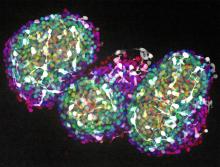
Researchers will test out more than 100 genetic mutations linked to Alzheimer’s disease and related dementias
In an article published in the journal Neuron, National Institutes of the Health (NIH) researchers outlined their plans for the iPSC Neurodegenerative Disease Initiative (iNDI), a project designed to help scientists better understand how genetic mutations lead to the brain cell damage underlying Alzheimer’s disease and other dementias. It is among the first projects supported by the NIH’s Center for Alzheimer’s and Related Dementias (CARD), which aims “to stimulate, accelerate, and support research that will lead to the development of improved treatments and preventions for these diseases.”
The project is led by the laboratories of Michael E. Ward, M.D., Ph.D., principal investigator at NIH’s National Institute of Neurological Disorders and Stroke (NINDS), and Mark Cookson, Ph.D., principal investigator at the NIH’s National Institute on Aging, (NIA).
iNDI relies on induced pluripotent stem cells (iPSCs). Like most stem cells, iPSCs can be raised in petri dishes to become new brain cells. However, iPSCs are different from other stem cells in that they can be derived, or reborn, out of a person’s skin or blood. Scientists have found the cells appealing to work with because they create the ability to study a patient’s disorder in disease-relevant cell types.
The downside of this approach is that cells from one person are genetically different from the cells of another. This makes it hard for scientists to consistently evaluate the impact a disease-causing mutation has on brain cells, and hard to figure out how different mutations relate to each other biologically.
To address this issue, the iNDI researchers plan to create a new set of induced pluripotent stem cell lines. Each line will carry one disease-causing mutation but in the same genetic background as all the other lines. They plan to do this for more than 100 different mutations known to cause Alzheimer’s disease and related dementias, making it the largest iPSC genome-engineering project to date.
Other scientists will be able to obtain samples of each cell line and any accompanying data that may result from future experiments. Drs. Ward and Cookson hope this library will speed the development of promising treatments for millions of people who suffer from these devasting disorders.
Article:
Ramos, D.M., et al. Tackling neurodegenerative diseases with genomic engineering: A new stem cell initiative from the NIH. Neuron, April 7, 2021.
###
NINDS is the nation’s leading funder of research on the brain and nervous system. The mission of NINDS is to seek fundamental knowledge about the brain and nervous system and to use that knowledge to reduce the burden of neurological disease.
About the National Institute on Aging (NIA): NIA leads the U.S. federal government effort to conduct and support research on aging and the health and well-being of older people. Visit the NIA website for information about a range of aging topics in English and Spanish. Learn more about age-related cognitive change and neurodegenerative diseases via its Alzheimer's and related Dementias Education and Referral (ADEAR) Center website. Stay connected with NIA!
About the National Institutes of Health (NIH): NIH, the nation's medical research agency, includes 27 Institutes and Centers and is a component of the U.S. Department of Health and Human Services. NIH is the primary federal agency conducting and supporting basic, clinical, and translational medical research, and is investigating the causes, treatments, and cures for both common and rare diseases. For more information about NIH and its programs, visit https://www.nih.gov.
